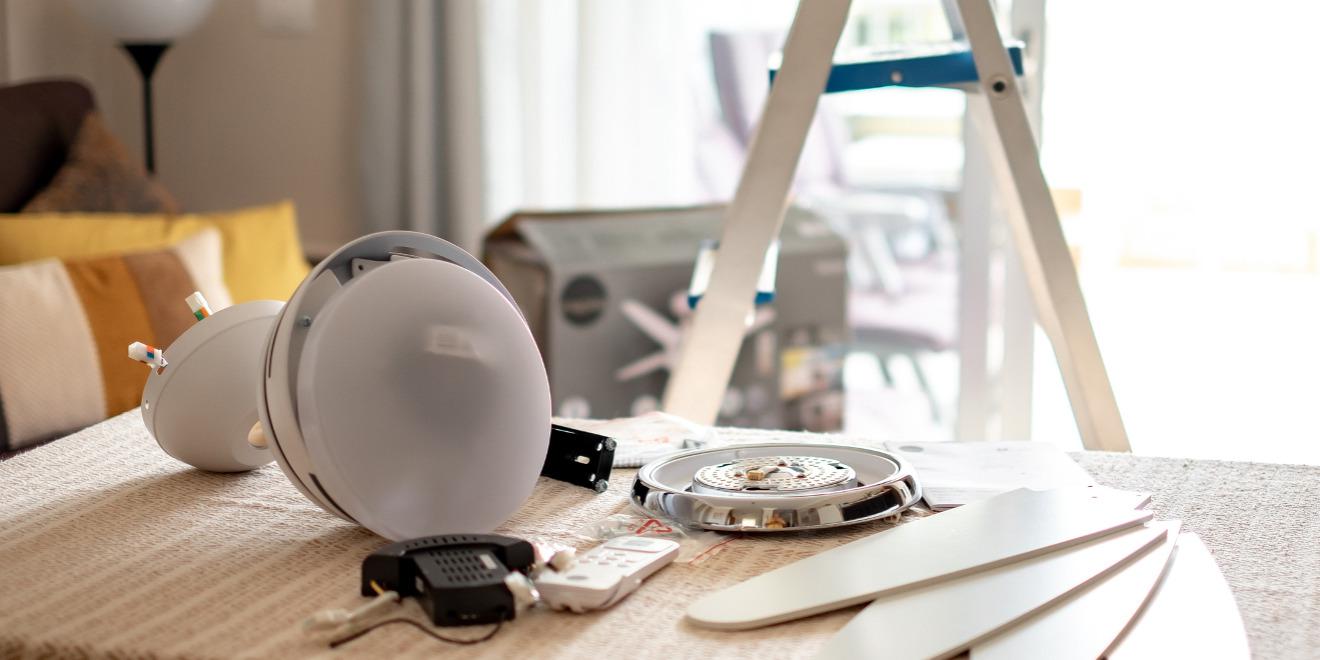Choosing the Right Ceiling Fan Size for Your Home: A Comprehensive Guide

Size matters—especially when it comes to shopping for a ceiling fan. Not just any fan will do. There are some things worth knowing before visiting your local home improvement big box, namely how size plays a role in your selection.
Choosing the right ceiling fan involves considering room size, ceiling height, blade span and pitch, style, and energy efficiency. By carefully evaluating these factors, you can select a fan that not only keeps your space comfortable but also complements your decor and helps reduce energy costs.
The goal is to find a fan that provides optimal air circulation while fitting seamlessly into your home's design. Whether you're cooling a small bedroom or a large open-concept living area, the right ceiling fan can make a world of difference in your comfort and your home's overall ambiance.
Room Size and Ceiling Height: The Foundation of Fan Selection
The size of your room is the primary factor in determining the ideal fan size. Here's a general guide based on room dimensions:
- For rooms up to 75 square feet: Choose a fan with a diameter of 29 to 36 inches
- For rooms 76 to 144 square feet: Opt for a fan between 36 to 42 inches in diameter
- For medium-sized rooms of 144 to 225 square feet: A fan size of 44 to 50 inches is suitable
- For larger spaces of 225 to 400 square feet: Consider fans sized 50 to 54 inches
- For areas exceeding 400 square feet: Fans with a diameter of 60 inches or more may be necessary
Ceiling height also plays a crucial role in fan selection and installation:
- For standard 8-foot ceilings: Install fans approximately 7 feet above the floor for safety and efficiency
- For 9-foot ceilings: A downrod of up to 6 inches may be needed
- For 10-foot ceilings: Downrods of 8 to 16 inches are recommended
- For 12-foot ceilings: Consider downrods of 18 to 30 inches
- For sloped ceilings: A downrod of 36 inches or more might be necessary based on the fan's size and the slope angle
Common Ceiling Fan Sizes: A Detailed Breakdown
When shopping for ceiling fans, you'll typically encounter four main size categories. Understanding these can help you make an informed decision based on your specific needs:
1. Small Fans
- Blade Span: 29-36 inches
- Recommended Room Size: Up to 75 square feet
- Ideal Usage: Small spaces such as bathrooms, hallways, utility rooms, or small home offices
- Notes: These compact fans are perfect for areas with limited space or where a larger fan might feel overwhelming
2. Medium Fans
- Blade Span: 36-50 inches
- Recommended Room Size: 76-175 square feet
- Ideal Usage: Medium-sized rooms like bedrooms, kitchens, dining rooms, or small living rooms
- Notes: This versatile size range is the most common, suitable for a wide variety of residential applications
3. Large Fans
- Blade Span: 50-60 inches
- Recommended Room Size: 175-350 square feet
- Ideal Usage: Larger spaces such as master bedrooms, living rooms, family rooms, or open-concept areas
- Notes: These fans provide substantial air movement and can serve as a striking design element in spacious rooms
4. X-Large Fans
- Blade Span: 60+ inches
- Recommended Room Size: 350+ square feet
- Ideal Usage: Very large open spaces, great rooms, patios, or rooms with high ceilings
- Notes: These oversized fans are designed to move large volumes of air efficiently in expansive areas
Blade Span and Pitch: The Science of Airflow
Blade span refers to the diameter of the circle created by the rotating blades. It's a major factor in determining how much air a fan can move. Generally, larger rooms require fans with longer blades to effectively circulate air throughout the space.
Blade pitch, or the angle of the blades relative to the horizontal plane, also affects air movement. A higher pitch typically moves more air, but it requires more energy to operate. The optimal blade pitch for most residential ceiling fans is between 12 to 15 degrees, balancing airflow and energy efficiency.
Style and Room Function: Marrying Form and Function
Different rooms may require different fan sizes and designs based on their function:
- Living rooms: Often benefit from larger fans with decorative elements that complement the room's decor
- Bedrooms: May require quieter, more compact fans with integrated lighting options
- Kitchens: Typically need smaller, more powerful fans to combat heat and odors
- Outdoor spaces: Require damp- or wet-rated fans designed to withstand exposure to moisture and elements
When selecting a fan, consider how its style will integrate with your room's existing decor. Many modern fans come in a variety of finishes and designs, allowing you to enhance your room's aesthetic while improving air circulation.
Performance and Efficiency
CFM, or Cubic Feet per Minute, is a measure of how much air a fan can move. Higher CFM ratings indicate more powerful air movement, which can be particularly beneficial in larger spaces or areas that require significant air circulation.
Energy efficiency is another crucial factor. Look for fans with the ENERGY STAR label, which can be up to 60% more efficient than conventional fan/light units. Many modern ceiling fans incorporate smart technologies, allowing for remote operation, scheduling, and integration with home automation systems, further enhancing energy efficiency and convenience.
Why a Professional Electrician Should Always Install Ceiling Fans
While selecting the right ceiling fan is crucial, ensuring its proper installation is equally important. Here's why hiring a professional electrician for ceiling fan installation is essential:
Safety Concerns
Ceiling fan installation involves working with electrical wiring, which can be dangerous if not handled correctly. Professional electricians are trained to work safely with electricity, minimizing the risk of electrical shocks, fires, or other hazards. They also understand the importance of proper grounding and can ensure that your fan is installed in a way that prevents electrical accidents.
Adherence to Electrical Codes
Electrical codes exist to ensure the safety and functionality of electrical installations. Professional electricians are well-versed in local, state, and national electrical codes. They can ensure that your ceiling fan installation complies with all relevant regulations, which is crucial for both safety and legal reasons. Non-compliant installations can lead to issues with home inspections or insurance claims.
Ensuring Proper Installation
Ceiling fans need to be securely mounted to support their weight and movement. Professional electricians have the knowledge and tools to properly install mounting brackets and ensure that the fan is balanced correctly. This prevents issues such as wobbling, noise, or the fan coming loose over time. They can also address challenges like installing fans on sloped ceilings or in rooms with non-standard electrical setups.
Preventing Potential Electrical Issues
Improper installation can lead to a range of electrical problems, from minor annoyances to serious hazards. These might include:
- Overloaded circuits
- Improper wiring connections
- Interference with other electrical systems in the home
- Reduced fan performance or efficiency
Professional electricians can assess your home's electrical system and ensure that the fan installation doesn't create any of these issues. They can also identify and address any pre-existing electrical problems that might affect the fan's operation.
Expert Advice and Warranty Protection
Professional electricians can provide valuable advice on fan operation, maintenance, and energy-saving practices. Additionally, many manufacturers require professional installation to maintain warranty coverage. By hiring a licensed electrician, you protect your investment and ensure that you can take advantage of warranty services if needed.
Why Choose Mister Sparky for Your Ceiling Fan Installation
When it comes to ceiling fan installation, Mister Sparky stands out as the premier choice for homeowners. Don't leave your ceiling fan installation to chance. Choose Mister Sparky for a professional, safe, and reliable installation that meets the highest standards of quality. Contact us today at (800) 906-4577 or visit our locations page to find a Mister Sparky electrician near you. Let us help you enhance your home's comfort and efficiency with expert ceiling fan installation services.
